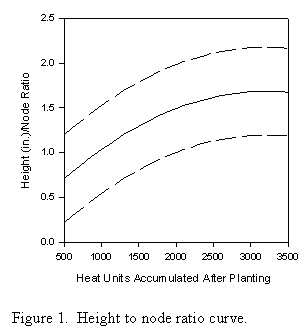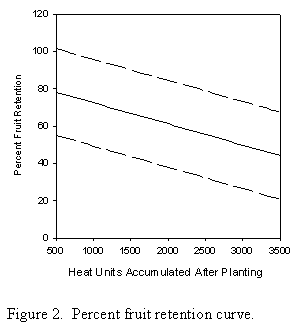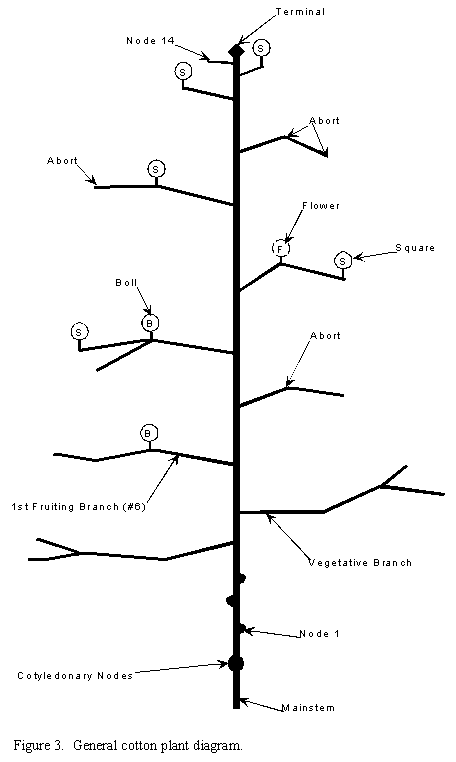Estimating Fruit Retention
(Publication az1208)
(PDF file version, 36KB)
by Jeffrey C. Silvertooth,
Extension Agronomist - Cotton
Managing for a vigorous cotton plant with a good balance of vegetative and reproductive growth is important for obtaining high yields, good quality, and earliness in desert-grown cotton. We have found that taking a plant height (inches) to node ratio (HNR) is an easy method of evaluating the vigor and balance for a cotton plant. By determining the HNR for a set of representative plants from any given field, the general vigor or balance of the crop can be found at any stage of growth by referring to the baselines which have been developed for Arizona cotton (Figure 1). This information can then be useful in managing crop inputs such as nitrogen fertilizer, plant growth regulators (such as PIXtm), and water.
For cotton crops which are irrigated in an optimal fashion (minimizing any water stress), and grown under extremely high temperature conditions (even relative to Arizona conditions), maximum growth potentials will be experienced. Plant growth under these conditions can lead to HNRs which may trend toward the upper thresholds of the baseline curves (Figure 1). Therefore, it is often important to make an estimate of the fruit retention level of the crop when making decisions about basic crop management. Baselines have also been developed for expected fruit retention levels for Arizona-grown cotton (Figure 2).
Developing fruit retention information basically requires a mapping of a set of cotton plants, which many people often avoid due to time requirements. However, simple estimates of fruit retention with a limited number of plants can be made in the field without going through extensive plant mapping exercises by: 1) counting the number of mainstem nodes, 2) determining the node number of the first fruiting branch, and 3) counting the number of aborted sites from the first and second fruiting positions from all fruiting branches.
For example, using the plant diagram in Figure 3, this plant has 14 mainstem nodes, the first fruiting branch (FFB) is at node 6, and there are therefore 5 vegetative branches (VB). There are a total of 7 aborted sites from the first 2 fruiting positions. From this we have: 14 total nodes - 5 (VB) = 9 fruiting branches, which gives a total of 18 fruiting sites to consider (9 fruiting branches * 2 positions = 18). Since there are 7 aborted sites, 18 - 7 = 11 retained sites, so (11 ¸ 18) * 100 = 61 % fruit retention. If this plant had accumulated about 1200 heat units after planting (HUAP), we would find by referring to Figure 2 that a 61% fruit retention would be slightly lower than ideal for this stage of growth. So, fruit retention estimates can be done quickly and the information, along with HNRs, can be very helpful in managing for a well-balanced cotton crop.
Issued in furtherance of Cooperative Extension work, acts of May 8 and June 30, 1914, in cooperation with the U.S. Department of Agriculture, James A. Christenson, Director Cooperative Extension, College of Agriculture and Life Sciences, The University of Arizona.
The University of Arizona is an equal opportunity, affirmative action institution. The University does not discriminate on the basis of race, color, religion, sex, national origin, age, disability, veteran status, or sexual orientation in its programs and activities.
Any products, services, or organizations that are
mentioned, shown, or indirectly implied in this web document do not imply
endorsement by The University of Arizona.
Information provided by Jeffrey C. Silvertooth, silver@ag.arizona.edu
Extension Agronomist - Cotton, College of Agriculture, The University of Arizona.
Material written February 2001.
Crop Mgmt | Soil Mgmt | Irrigation | Varieties | Cotton Comments
Home | Cotton | Advisories
document located at: http://cals.arizona.edu/crops/cotton/cropmgt/fruit_retention.html
Copyright © 2001 University of Arizona,
College of Agriculture and Life Sciences
Webmaster: Al Fournier (acis@ag.arizona.edu)


